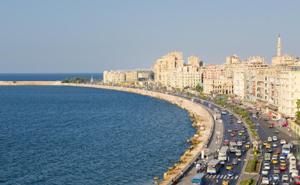Case-study /
Egypt: Sea-Level Rise and Impacts in Africa, 2000 to 2100. Application of the DIVA model to Africa.


City of Alexandria coastline: Image ©Blueskyline.com
Impact of sea level rise in Egypt
Egypt has a coastal zone of more than 3,500 km long and contains 40% of the country’s total population of 82 million people (Elsharkawy et al., 2009). It is located in an arid to semi-arid zone with a terrain of desert plateau interrupted by the Nile valley and delta. The majority of the population live in and around the major cities of Alexandria, Port Said, Damietta, Rosetta, and Suez on the Mediterranean coast (El-Raey, 1999). A large portion of the 50 km wide coastal strip lies below 2 m above mean sea level and is protected from inundation and flooding only by a 1 km to 10 km wide coastal sand belt shaped by discharges from the Rosetta and Damietta branches of the Nile River (Elsharkawy et al., 2009). The sand belt, which also protects coastal lakes and lagoons, is experiencing rapid erosion associated with the construction of the Aswan high dam (Stanley, 1996; Stanley and Warne, 1998). Ericson et al. (2006) estimated that 1.3 million people could be displaced by 2050, just based on present trends (see Table 2). Sea-level rise will only exacerbate the problem endangering the fishing industry as one third of the country’s fish catch is from these threatened lakes and lagoons (Elsharkawy et al., 2009).
Previous studies on impacts of sea-level rise showed without additional adaptation inundation and erosion could result in a loss of significant proportion of the northern part of the Nile delta, with the loss of agricultural land and urban areas (without any additional adaptation) (Khafagy et al., 1992; Stanley and Warne, 1993). Dasgupta et al. (2009) ranked Egypt as the first and second most impacted developing country (of 84 developing coastal nations) by 1 m of sea-level rise in terms of potential loss of agricultural land and population displacement, respectively. With this magnitude of sea-level rise, the nation will experience an estimated 6.44% decrease in GDP resulting in the loss of 28,000 km2 of agricultural land (>13% of the national total), 25,000 km2 of urban area (>5% of the national total) and 24,000 km2 of wetland loss (>6% of the national total). Thus Egypt is highly threatened due to infrastructure and population dependent on the coast and Nile for water resources and agriculture.
Egypt’s second largest city, Alexandria (see also Table 3), is subsiding at 2 mm/yr and even without climate change is highly vulnerable to flooding and erosion, as 35% (700 km2) of the land area is below mean sea level (El-Raey et al., 1995). With a 1 m sea-level rise, it is estimated that 68% (1,200 km2) of its land could be inundated (Leatherman and Nicholls, 1995). The same magnitude could also force to relocate 8 million people (i.e. whole of Alexandria’s population and 4 million people in the Nile delta), assuming 1990 population and no upgrade in protection levels (Broadus et al., 1986; Milliman et al., 1989). An OECD study report on Egypt also estimated a total loss of land, properties and revenues costing in the range of US$30 billion for the city of Alexandria under a 0.5m sea-level rise of ‘do nothing’ scenario (Agrawala et al., 2004). The same scenario causes a total of US$2.9 billion loss from land and property for Rosetta city (El-Raey et al., 1999; Agrawala et al.,2004).
Port Said, an important industrial, trade and tourist centre containing 0.5 million people and Egypt’s second largest harbour is subsiding at 5mm/yr and, sea-level rise and its potential impacts would therefore become more severe than other parts of the Nile delta (El-Raey, 1997). A 0.5 m rise in sea level could result in a loss of 13% (0.05 km2) industrial, 8% (0.46 km2) urban area and 1.6% (21 km2) beach area, and other physical and socio-economic losses in Port Said governorate, costing more than US$2.2 billion (El-Raey et al., 1999; Agrawala et al., 2004).
For other coasts in Egypt on the Mediterranean and on the Red Sea, little is known about their vulnerability to sea-level rise. While these areas are not generally low-lying, any tourism and infrastructure developments may be significantly at risk from relative sea-level rise.
Suggested citation
Brown, S., Kebede, A.S., and Nicholls, R.J. (2011).Sea-Level Rise and Impacts in Africa,2000 to 2100. University of Southampton, UK, 215pp
